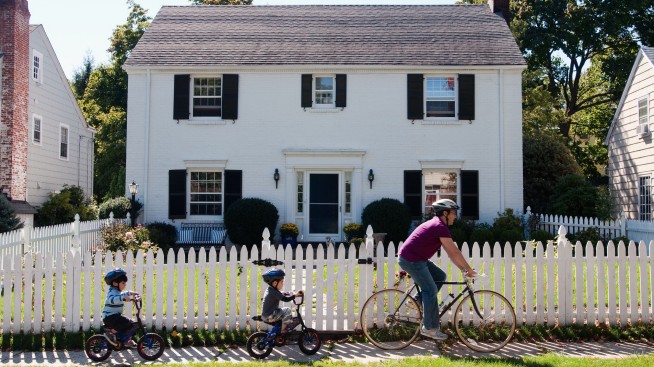Different types of houses to know for your search

Before embarking on your house hunting journey, you may want an overview of the different types of houses found on the market, such as townhouses and condos. Understanding the difference between house structures can help you narrow down and inform your search. Whether you are undecided about the house structure you want or are looking for something specific, knowing the different types of houses can help you pick the best home for you.
House types in your house hunt
There are several different types of house structures, which aren’t to be confused with house styles. Structure refers to the home’s size, shape and possible proximity to other homes. Style refers to the home’s design and features, like contemporary or craftsman. We’ll be focusing on types of house structures.
Single-family homes
A single-family home is a detached, stand-alone structure that may be inhabited by families, couples or individuals. Single-family homes come in many different styles, according to the U.S. Census Bureau, a single-family house is one that may be fully detached, semi-detached, a row house or a townhome. It’s a common type of home you may see in a typical U.S. suburban neighborhood.
A single-family home may be advantageous if you want more space, privacy and freedom to make the space your own. However, the owner of a single-family home is responsible for all or most maintenance costs, as opposed to some housing communities where utilities and maintenance may be managed by the building owner or association.
Multifamily homes
The difference between a single-family home and a multifamily home is that a multifamily home has more than one living unit within. For example, a single home could have a basement apartment unit that the owner rents out. But multifamily homes also include duplexes (a single house with two living units separated by a shared wall and private entrances) and small apartment complexes (a single structure of up to four living units with private entrances).
A multifamily home could be advantageous for people looking to live with aging parents or extended family members. It may also be beneficial for people hoping to help pay their mortgage with rental income. On the other hand, a multifamily home could come with the responsibility for (and increased cost of) the maintenance of several living areas. And owners may have to consider the possibility of unit vacancies, late rent payments, and having to live where they also work as a landlord.
A mortgage for a multifamily home could look pretty similar to a single-family home, but potentially with different lending qualifications. However, you may want to note that the down payment may be higher than other house types because of the large property size. This could also mean higher property taxes and homeowner’s insurance.
Condos
A condominium, or condo, is a privately owned unit within a community of other privately owned units. Condos can be a townhouse, row house, in a high-rise building or detached in some suburban communities. You can think of condos as a compromise between apartments and single-family homes. The main difference between a condo and an apartment is that an apartment is rented, and a condo is owned. While there may be shared areas like pools or recreation centers, condos can come with a bit more privacy than apartments.
One thing to consider when purchasing a condo is the additional fees that may be imposed by a Homeowners Association (HOA) which typically manages common areas in the community or seasonal maintenance like plowing snow and mowing lawns. The HOA fee should be considered when calculating your total monthly payments.
Townhouses
A townhouse is another type of home that’s privately owned by a resident. But instead of a high rise or a detached unit, townhouses are multi-story units with one or more walls attached to another privately owned home. Townhouses may look like a large single-family home, but each unit has a private entrance and possibly a private garage. Townhouses may be single-family homes or condos.
A townhouse may be the optimal choice if you want to spend less than you would on a single-family home but keep your privacy. However, it may not work for someone looking for lots of outdoor space or open living area inside, as townhouse properties can be on the narrow side.
You may also want to consider that townhouses are typically subject to the rules of an HOA, and you may have to pay any fees associated with the organization.
Co-ops
Co-ops, also called housing cooperatives, are more common in large cities like New York. People get living space in the building when they purchase shares of the co-op corporation. When you buy a co-op, you’re buying shares of the corporation and then an occupancy agreement or proprietary lease is signed which allows you to occupy the units your shares are attributed.
A co-op may be ideal for someone who wants shared responsibility in upkeep and to have a say in building management and fellow residents. It may not work if you want more privacy or want to avoid how co-op board rules may apply.
If you’re buying into a co-op, note that your mortgage options may be limited because co-op mortgages are different than those for other home types — and some lenders do not offer them.
Modular homes
Manufacturers build modular homes part-by-part. They frequently have box-like structures that, when placed together and secured, make a whole house. Once complete, they are covered, shipped to your home and set on top of a premade foundation laid by a builder.
If you’re looking for a newer, cost-friendly option, then you may want to consider a modular home. Today, modular homes can look just like other single-family homes. However, your design options are likely limited.
Modular homes can often be financed with a standard mortgage.
Manufactured homes
You may be familiar with the term “mobile home,” because that’s what manufactured homes used to be called. Manufactured homes don’t normally have any onsite construction. They’re built in a factory and wheeled to their destination. Like modular homes, they are secured onto a base of concrete at the home’s desired location.
Since manufactured homes evolved from mobile homes, they typically run smaller than modular models but come with the perk of being easy to move! This means that if you’re not loving your neighborhood then you can literally move your home somewhere else. If you aren’t looking to take advantage of your home’s mobility, then you can cover or remove the wheels. If you do end up wanting to move, then your manufacturer should be able to come and reattach them.
The most common method of financing a manufactured home is through a retail installment contract, which may be available through your retailer.
In summary
You’ll find many types of homes to choose from in the U.S. Some of the common types are single and multifamily homes, condos, townhouses, co-ops, modular homes and manufactured homes. Knowing the different home structures can help you embark on your exciting house hunting journey and choose the home that best suits you.



